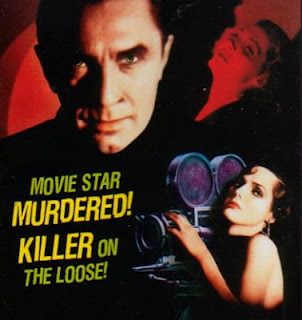The Wolf Man (1941)
Starring: Lon Chaney Jr., Claude Rains, Evelyn Ankers, Maria Ouspenskaya, Warren William, and Bela Lugosi
Director: George Waggner
Steve's Rating: Seven of Ten Stars
Engineer Larry Talbot (Chaney) returns to his ancestral home and reconnects with his roots... only to be bitten by a werewolf and find himself cursed. Will he manage to find a cure for a malady that no one in the modern world believes in before he kills someone he loves?

"The Wolf Man" isn't the first werewolf movie--I think that was Universal's "Werewolf of London"--but it's the one that brought werewolves firmly into pop culture, and most every other film, novel, or comic book that's followed in the 65+ years since its release owes one thing or another to it. In fact, there are a numer of elements that are now taken as "fact" about werewolf legends that didn't exist until the writer of "The Wolf Man" made them up.
Interestingly, this really isn't that good a movie. It's sloppily edited--leading to characters entering through the same door twice within a few seconds and other glitches--and the script shows signs of only partially implimented rewrites that gives the flm a slightly schizophrenic quality and that causes characters to seemingly forget key plot elements as the story unfolds. (The biggest one; Larry's given an amulet that will supposedly suppress his transformation, an amulet he gives to a lady friend when he thinks the werewolf stuff is a bunch of hooey. Later, though, he seems to have totally forgotten the purpose of the amulet. And let's not even consider the bad script-induced callousness of our heroine, Gwen, who cheerfully goes on a date the night after a good friend is mysteriously murdered in the woods.)
However, what flaws this movie possesses are rendered insignificant thanks to an amazing performance by Lon Chaney Jr. as the tortured werewolf, Larry Talbot. "The Wolf Man" is one of those rare movies where a single actor manages to lift a weak film to the level of a classic. Although he's assisted by a supporting cast that is a veritable who's-who of 1930s and 1940s genre films, and the set designers and dressers went all out, this is truly it is Lon Chaney Jr's movie. It might even be the brightest moment of his entire career.
Chaney plays a decent man who becomes a monster through no fault of his own, and who is horrified by the acts he commits while he is the wolf man. This makes Larry Talbot unique among all the various monsters in the Universal horror picutres of the 1930s and 1940s, and Chaney makes the character even more remarkable by playing him as one of the most likeable (if a bit smarmy when it comes to the ladies) characters in any of the classic horror films. This likeability makes Chaney's performance even more powerful and causes the viewer to feel even more deeper for Larry when he experiences the grief, helplessness, and terror when he realizes that he is a murderer and the victim of a supernatural affliction that his modern, rational mind can't even begin to comprehend.
There are other good performances in the film, and they too help make up for the weak script. Most noteworthy among these is Maria Ouspenskaya who plays a gypsy wise-woman. Ouspenskaya delivers her magic incantations and werewolf lore with such conviction that it's easy to see why they've become the accepted "facts" of werewolves. (This may also be the first film where gypsies became firmly associated with werewolves.)
Lugosi only has a small part, but crucial, part and he does alot with it. He is at his most mysterious in the role of a gypsy who is at the root of Larry Talbot's curse. Lugosi would also appear in the first Wolf Man sequel, a crossover with the Frankenstein series titled "Frankenstein Meets the Wolf Man."
Although flawed, "The Wolf Man" is a cornerstone of modern popular horror, and it's well-deserving of its status as a classic. It should be seen by lovers of classic horror pictures (Lon Chaney Jr. deserves to be remembered for this film and it's required viewing for any self-respecting fan of werewolf films and literature.












